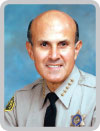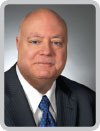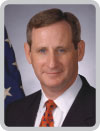Cities, Counties, States Security
 Leroy Baca,
Leroy Baca,
Sheriff, Los Angeles County, California
Since becoming Sheriff of Los Angeles County in 1998, Lee Baca and his command staff have developed and implemented a number of strategies to positively impact residents. The Community Oriented Policing Services Bureau (COPS Bureau) finds long-term solutions to crime trends impacting neighborhoods in the unincorporated areas of Los Angeles. COPS Bureau deputies use a face-to-face approach to remove barriers that have formed over time between law enforcement and the neighborhoods they patrol. Another strategy is the VIDA (Vital Intervention and Directional Alternatives) Program designed for at-risk youth between ages 11 and 17, which is operated by the COPS Bureau from eight sites. Since its inception, more than 6,000 families have participated in the program, which involves students in 10 hours of supervised activity each week, eight hours on Saturdays, and two-hour midweek counseling sessions. Also, the Parolee Monitoring Program collects and disseminates information regarding some 30,000-plus inmates placed on Non-Revocable Parole status. The Department’s technology-based strategies include a law enforcement information sharing program that involves COPLINK, a tactical, line-level analytical solution designed to address common problems in law enforcement information systems.
 William J. Bratton,
William J. Bratton,
Chairman, Kroll; Former Commissioner New York City Police Department and
Former Chief, City of Los Angeles Police Department
William Bratton is one of America’s premier police chiefs and the only person to have led both the two largest police forces in the United States – the New York Police Department and the Los Angeles Police Department (LAPD). Bratton is now chairman of Kroll, a risk consulting company, which he joined in November 2009 after serving as LAPD chief for seven years. Bratton revitalized police morale and significantly cut crime in each of the four law enforcement leadership positions he has held, which also include New York City Transit police chief and Boston Police Commissioner. In the process, he established an international reputation for re-engineering police departments and fighting crime. In the New York Police Department, Bratton led development and deployment of CompStat, an accountability process and management program based on comparative statistics that is similar to Six Sigma and Total Quality Management (TQM) programs. In 1999, before returning to public service as LAPD chief in 2002, Bratton formed his own company, The Bratton Group LLC, as a consultant on safety and security throughout the United States and on four continents, including extensive work in South America.
 Cathy Lanier,
Cathy Lanier,
Chief, Washington, D.C.
Metropolitan Police
Cathy Lanier was named Chief of the Metropolitan Police Department by D.C. Mayor Adrian Fenty in 2007. She was 39 at the time and the first woman to take on one of the most high-profile, demanding jobs in law enforcement. Lanier’s management style is to listen, build consensus and create specialized teams around her. Her priorities include making police more visible on the street, improving department efficiency and lifting morale by empowering officers and supervisors. Lanier had spent her entire law enforcement career with the department, most of it on the front lines. Since joining the department in 1990, Lanier has displayed her inclusive management style and tireless work ethic in a rapid rise through several positions, including Commander of the Fourth District, one of the largest and most diverse residential patrol districts in the city. She also served as the commanding officer of the Department’s Major Narcotics Branch and Vehicular Homicide Units. More recently, Lanier served as Commander of the Special Operations Division (SOD) for four years. During her tenure as SOD Commander, she established the agency’s first Homeland Security/Counter-Terrorism Branch and created an agency-wide chemical, biological, radiological response unit known as the Special Threat Action Team.
Defense Industrial Base Security
 Arthur Cummings,
Arthur Cummings,
Executive Assistant Director for National Security Branch, FBI
When Arthur M. Cummings II was named executive assistant director of the FBI’s National Security Branch in 2008, it was the culmination of a 20-year FBI career. The job involves overseeing the FBI’s Counterterrorism, Counterintelligence, Weapons of Mass Destruction and Intelligence programs, as well as the Terrorist Screening Center. Cummings is also the lead FBI official responsible for coordination and liaison with the U.S. Director of National Intelligence and the rest of the Intelligence Community. At every level, from street agent to field supervisor to headquarters executive, Cummings’ career has concentrated on investigating and managing counterterrorism and counterintelligence operations. He has served in five field offices and in three different positions in the Counterterrorism Division at FBI headquarters. In the field, he investigated and managed counterterrorism, counterintelligence and various criminal programs. He also deployed overseas to support major counterterrorism investigations. Following the Sept. 11, 2001, terrorist attacks, Cummings was assigned to the Counterterrorism Division at FBI Headquarters. He played a key role in the reorganization of the counterterrorism program and established the position of Chief of the National Strategic Assessment and Warning Section. He served as chief of the Counterterrorism Operational Response Section, charged with developing and overseeing FBI operations in foreign theaters such as Afghanistan.
 Edward Halibozek,
Edward Halibozek,
Vice President and Chief Security Officer, Northrop Grumman
Edward Halibozek’s career in industrial security spans more than 30 years. In 1985, he joined Northrop Grumman and has been the corporation’s senior security executive since 1995. Halibozek works from the company’s Los Angeles headquarters, where he is responsible for oversight of all company-wide security programs. Northrop Grumman is a global defense company with approximately 120,000 employees and operations in all 50 states and 25 countries. Halibozek chairs the Northrop Grumman Security Council, working to develop a common, company-wide approach to addressing security strategies, processes, issues and problems. The Security Council is the key deliberative body for security, fire, contingency planning, and investigative issues and opportunities facing the company. In addition, Halibozek is responsible for developing and implementing security processes that protect the people, information and property at the corporate office locations. Halibozek has contributed to security as a security professional, an author and a teacher. He has co-authored five books on security, including the broad-based “Manager’s Handbook for Corporate Security” and “Introduction to Security” (eighth edition). Halibozek also teaches a course on security management at California State University Fullerton.
 Ray Musser,
Ray Musser,
Staff Vice President Security,
General Dynamics Corp.
Ray Musser directs global security operations for General Dynamics, an aerospace and defense company with $32 billion in annual revenue in 2009 and 91,000 employees worldwide. He is responsible for all aspects of security activities including the company’s information security operations and compliance programs. Since joining General Dynamics in 1984, he has led efforts to foster and encourage partnership and information sharing among law enforcement, the intelligence community and the private sector. He continues to be a champion of this approach in his leadership roles as co-chair of the FBI’s National Security Business Alliance, where he helps to tailor and advocate the FBI’s outreach initiatives to industry. Musser was an early proponent of combining the traditional security discipline and cyber security discipline under one umbrella. Highlights of Musser’s 30-year career in security and law enforcement also include development and implementation in 2002 of General Dynamics’ global security operations, named the Global Incident Response Center. Musser identified the need to have worldwide situational awareness of employees when they were on company travel or working offsite for a customer program. He led the effort to implement a reporting and tracking system, combined with a security staffing model that allowed the company to have key expert staff available 24/7 worldwide.
 Steven Shirley,
Steven Shirley,
Executive Director,
DoD Cyber Crime Center (DC3)
Steven Shirley’s first tour of duty as a special agent with the Air Force Office of Special Investigations involved him in counterintelligence and security support to national space systems. It also introduced him to collaboration between the government and the Defense Industrial Base (DIB), which includes tens of thousands of companies and their subcontractors who contract with the Department of Defense. Later at the Office of the Secretary of Defense, Shirley worked to protect sensitive programs of defense contractors during arms control treaty inspections. Since 2004, Shirley has created a model for sharing cyber threat data with the DIB. Shirley was a principal participant in discussions with senior officers of defense contractors, beginning in 2005, which led to a Deputy Secretary of Defense decision in 2007 to create an unprecedented public-private sharing model to exchange cyber threat data. Under the DoD Cyber Security/Info Assurance Program, Shirley organized the DoD/DIB Collaborative Information Sharing Environment at the DC3, which began pilot operations in February 2008 as the operational “front door” for cyber threat sharing with defense contractor companies. The network DC3 built for this purpose, now migrated to the Defense Information Systems Agency (DISA), at maturity will be a conduit to the defense contractor community for other multi-disciplinary threat and security data.







